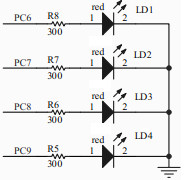gpiogeneral-purposeinput/output通用输入/输出端口
GPIO寄存器缩写列表

GPIO端口的每个位能够由软件别离装备成多种形式。

复位期间和刚复位后,复用功用未敞开,I/O端口被装备成浮空输入形式。
LED硬件衔接如下图所示:高电平点亮LED。

要想成功点亮一个LED,程序所需如下过程:(有必要的)
第一步:装备体系时钟。见STM32F103xRCC寄存器装备
除此之外,还需将GPIO外设时钟翻开。
/* Enable GPIOC clock */
RCC_APB2PeriphClockCmd(RCC_APB2Periph_GPIOC, ENABLE);
第二步:装备中断向量表。决议将程序下载到RAM中仍是FLASH中。今后讲。
void NVIC_Configuration(void)
{
#ifdef VECT_TAB_RAM //VECT_TAB_RAM没在程序中界说,所以将程序下载到Flash中
/* Set the Vector Table base location at 0x20000000 */
NVIC_SetVectorTable(NVIC_VectTab_RAM, 0x0);
#else /* VECT_TAB_FLASH */
/* Set the Vector Table base location at 0x08000000 */
NVIC_SetVectorTable(NVIC_VectTab_FLASH, 0x0);
#endif
}
第三步:装备GPIO的形式。输入形式仍是输出形式。本章要点。
void GPIO_Configuration(void)
{
GPIO_InitTypeDef GPIO_InitStructure;
/* Configure PC.06, PC.07, PC.08 and PC.09 as Output push-pull */
GPIO_InitStructure.GPIO_Pin = GPIO_Pin_6 | GPIO_Pin_7 | GPIO_Pin_8 | GPIO_Pin_9;
GPIO_InitStructure.GPIO_Speed = GPIO_Speed_50MHz;
GPIO_InitStructure.GPIO_Mode = GPIO_Mode_Out_PP;
GPIO_Init(GPIOC, &GPIO_InitStructure);
}
其实,运用GPIO非常简略,只需填写如下结构体的成员变量
typedef struct
{
u16 GPIO_Pin; //哪个管脚
GPIOSpeed_TypeDef GPIO_Speed; //如果是输出形式的话,还需要设置速度
GPIOMode_TypeDef GPIO_Mode; //管脚的类型
}GPIO_InitTypeDef;
提示
void GPIO_SetBits(GPIO_TypeDef* GPIOx, u16 GPIO_Pin)
{
/* Check the parameters */
assert_param(IS_GPIO_ALL_PERIPH(GPIOx));
assert_param(IS_GPIO_PIN(GPIO_Pin));
GPIOx->BSRR = GPIO_Pin;
}
涉及到GPIO_BSRR寄存器,如下所示

又牵扯到GPIOx_ODR,如下所示

vGPIO_ResetBits向指定Port指定Pin写0:
void GPIO_ResetBits(GPIO_TypeDef* GPIOx, u16 GPIO_Pin)
{
/* Check the parameters */
assert_param(IS_GPIO_ALL_PERIPH(GPIOx));
assert_param(IS_GPIO_PIN(GPIO_Pin));
GPIOx->BRR = GPIO_Pin;
}
涉及到GPIO_BRR寄存器,如下所示


/* Includes ——————————————————————*/
#include “stm32f10x_lib.h”
/* Private function prototypes ———————————————–*/
void RCC_Configuration(void);
void NVIC_Configuration(void);
void GPIO_Configuration(void);
void Delay(vu32 nCount);
/*******************************************************************************
* Function Name : main
* Description : Main program.
* Input : None
* Return : None
*******************************************************************************/
int main(void)
{
#ifdef DEBUG
debug();
#endif
/* Configure the system clocks */
RCC_Configuration();
/* NVIC Configuration */
NVIC_Configuration();
/* Configure the GPIO ports */
GPIO_Configuration();
/* Infinite loop */
while (1)
{
GPIO_SetBits(GPIOC,GPIO_Pin_6);//点亮LED1
Delay(1000000);
Delay(1000000);//多点亮一会,使人能看到LED的切当改变
GPIO_ResetBits(GPIOC,GPIO_Pin_6);//平息LED1
GPIO_SetBits(GPIOC,GPIO_Pin_7);//点亮LED2
Delay(1000000);
Delay(1000000);
GPIO_ResetBits(GPIOC,GPIO_Pin_7);//平息LED2
GPIO_SetBits(GPIOC,GPIO_Pin_8);//点亮LED3
Delay(1000000);
Delay(1000000);
GPIO_ResetBits(GPIOC,GPIO_Pin_8);//平息LED3
GPIO_SetBits(GPIOC,GPIO_Pin_9);//点亮LED4
Delay(1000000);
Delay(1000000);
GPIO_ResetBits(GPIOC,GPIO_Pin_9);//平息LED4
}
}
/*******************************************************************************
* Function Name : RCC_Configuration
* Description : Configures the different system clocks.
* Input : None
* Return : None
*******************************************************************************/
void RCC_Configuration(void)
{
ErrorStatus HSEStartUpStatus;
/* RCC system reset(for debug purpose) */
RCC_DeInit();
/* Enable HSE */
RCC_HSEConfig(RCC_HSE_ON);
/* Wait till HSE is ready */
HSEStartUpStatus = RCC_WaitForHSEStartUp();
if (HSEStartUpStatus == SUCCESS)
{
/* Enable Prefetch Buffer */
FLASH_PrefetchBufferCmd(FLASH_PrefetchBuffer_Enable);
/* Flash 2 wait state */
FLASH_SetLatency(FLASH_Latency_2);
/* HCLK = SYSCLK */
RCC_HCLKConfig(RCC_SYSCLK_Div1);
/* PCLK2 = HCLK */
RCC_PCLK2Config(RCC_HCLK_Div1);
/* PCLK1 = HCLK/2 */
RCC_PCLK1Config(RCC_HCLK_Div2);
/* PLLCLK = 8MHz * 9 = 72 MHz */
RCC_PLLConfig(RCC_PLLSource_HSE_Div1, RCC_PLLMul_9);
/* Enable PLL */
RCC_PLLCmd(ENABLE);
/* Wait till PLL is ready */
while(RCC_GetFlagStatus(RCC_FLAG_PLLRDY) == RESET) {}
/* Select PLL as system clock source */
RCC_SYSCLKConfig(RCC_SYSCLKSource_PLLCLK);
/* Wait till PLL is used as system clock source */
while(RCC_GetSYSCLKSource() != 0x08) {}
}
/* Enable GPIOC clock */
RCC_APB2PeriphClockCmd(RCC_APB2Periph_GPIOC, ENABLE);
}
/*******************************************************************************
* Function Name : NVIC_Configuration
* Description : Configures Vector Table base location.
* Input : None
* Return : None
*******************************************************************************/
void NVIC_Configuration(void)
{
#ifdef VECT_TAB_RAM
/* Set the Vector Table base location at 0x20000000 */
NVIC_SetVectorTable(NVIC_VectTab_RAM, 0x0);
#else /* VECT_TAB_FLASH */
/* Set the Vector Table base location at 0x08000000 */
NVIC_SetVectorTable(NV%&&&&&%_VectTab_FLASH, 0x0);
#endif
}
/*******************************************************************************
* Function Name : GPIO_Configuration
* Description : Configures the different GPIO ports.
* Input : None
* Return : None
*******************************************************************************/
void GPIO_Configuration(void)
{
GPIO_InitTypeDef GPIO_InitStructure;
/* Configure PC.06, PC.07, PC.08 and PC.09 as Output push-pull */
GPIO_InitStructure.GPIO_Pin = GPIO_Pin_6 | GPIO_Pin_7 | GPIO_Pin_8 | GPIO_Pin_9;
GPIO_InitStructure.GPIO_Speed = GPIO_Speed_50MHz;
GPIO_InitStructure.GPIO_Mode = GPIO_Mode_Out_PP;
GPIO_Init(GPIOC, &GPIO_InitStructure);
}
/*******************************************************************************
* Function Name : Delay
* Description : Inserts a delay time.
* Input : nCount: specifies the delay time length.
* Return : None
*******************************************************************************/
void Delay(vu32 nCount)
{
for(; nCount != 0; nCount–);
}
#ifdef DEBUG
/*******************************************************************************
* Function Name : assert_failed
* Description : Reports the name of the source file and the source line number
* where the assert_param error has occurred.
* Input : – file: pointer to the source file name
* – line: assert_param error line source number
* Return : None
*******************************************************************************/
void assert_failed(u8* file, u32 line)
{
/* User can add his own implementation to report the file name and line number,
ex: printf(“Wrong parameters value: file %s on line %d\r\n”, file, line) */
/* Infinite loop */
while (1)
{
}
}
#endif
怎么调试:在while(1)处设个断点。
履行完GPIO_Configuration函数后,调查GPIO_CRL和GPIO_CRH寄存器,能够看到:

每个管脚形式装备由GPIO_CRL或GPIO_CRH中的4位决议,例如:PC6管脚由GPIO_CRL中的MODE6[1:0]和CNF6[1:0]这4位决议,其他的以此类推。
涉及到GPIO_CRL寄存器,如下所示


因为MODE6[1:0]=11,检查上述表格,能够得出PC6是输出形式,且最大速度是50MHZ。因为CNF6[1:0]=00且为输出形式,所以以通用推挽输出形式运用输出驱动器。
履行完GPIO_SetBits(GPIOC,GPIO_Pin_6); //点亮LED1,能够看到:GPIO_ODR的ODR6=1
履行完GPIO_ResetBits(GPIOC,GPIO_Pin_6); //平息LED1,能够看到:GPIO_ODR的ODR6=0
其他管脚如此类推。









